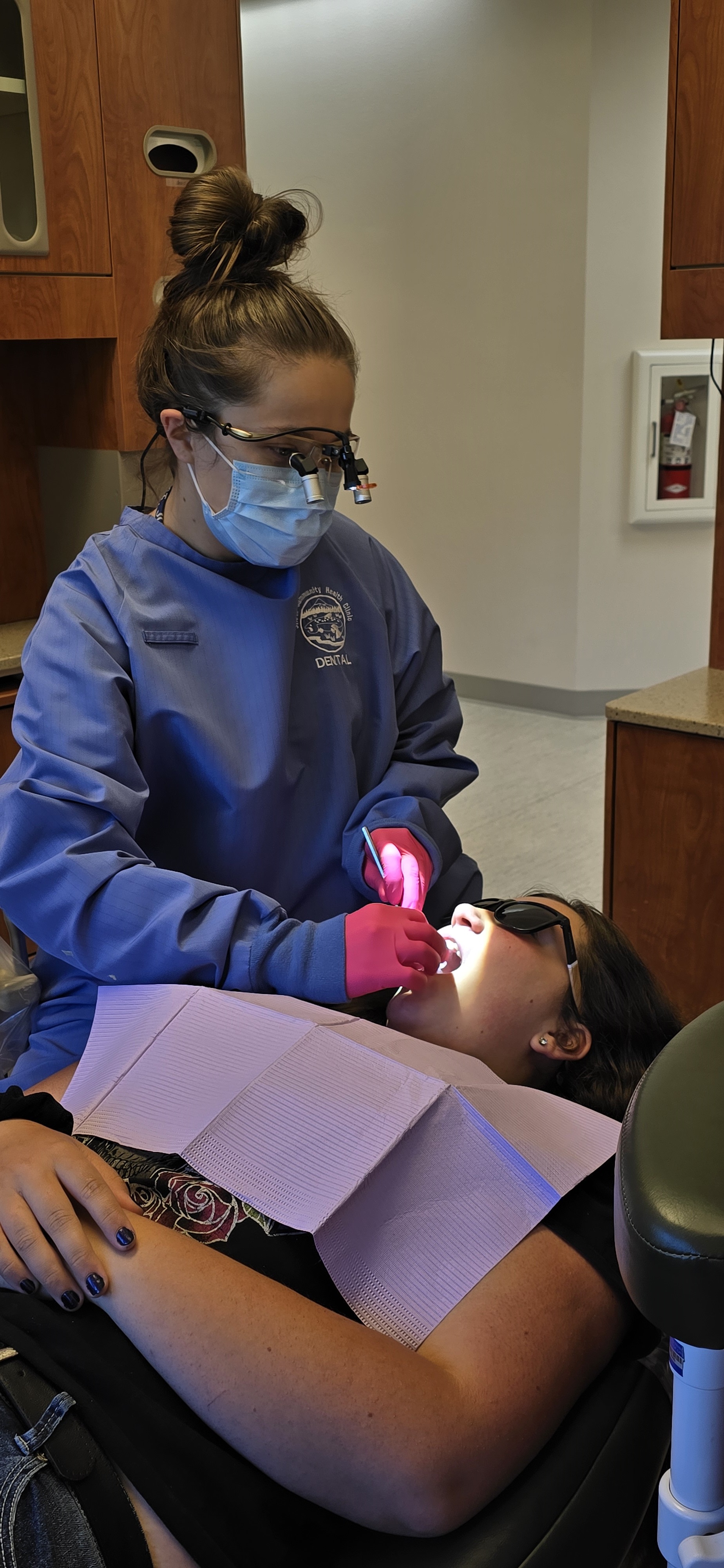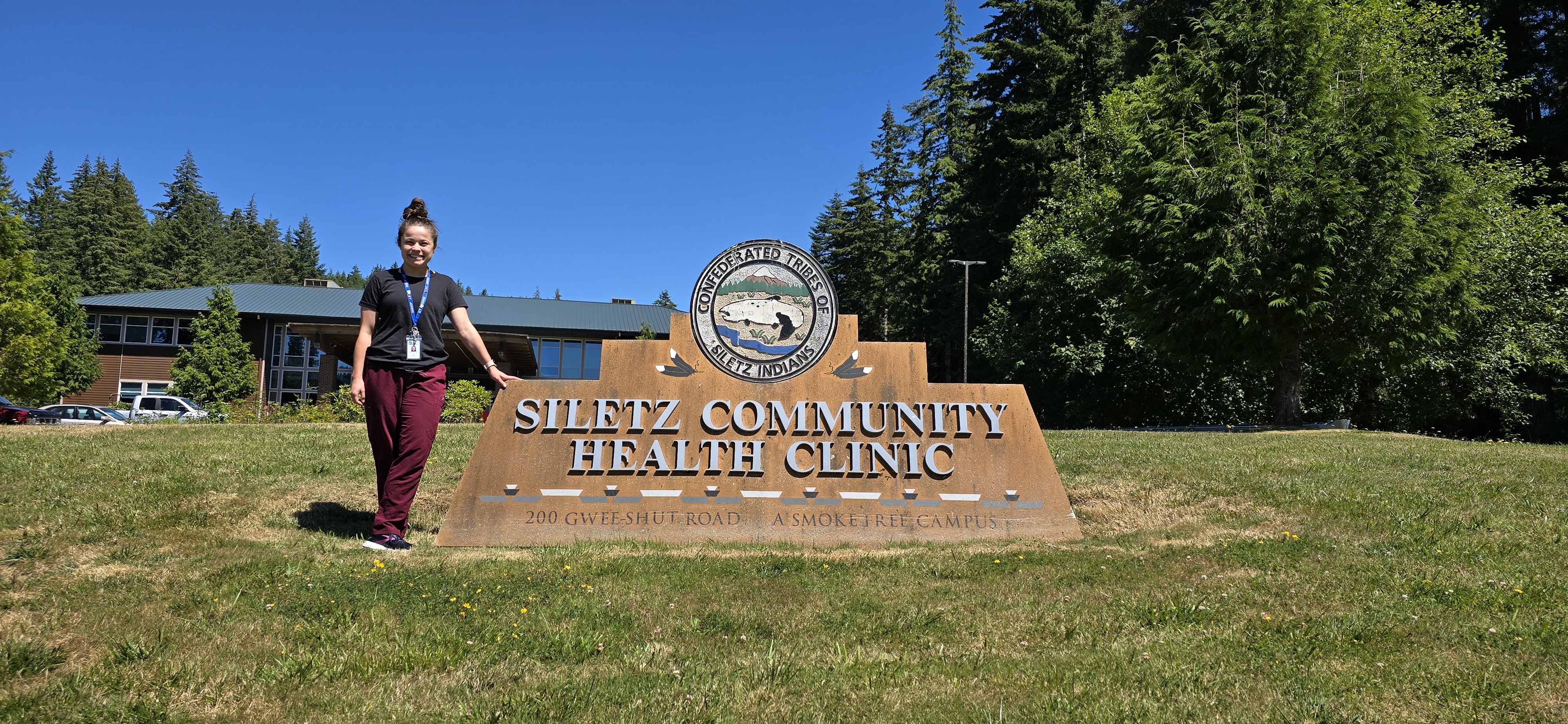Dr. Rachel Meek: Breaking Barriers and Building Trust Between Native Dentists and Patients
Growing up with both of her parents working in medicine, Dr. Rachel Meek said there’s no way she was going to follow in their footsteps. Today, as one of two dentists working for the Confederated Tribes of the Siletz Indians, she concedes that she is doing exactly what she was always meant to do.
While earning her undergraduate degree at Washington State University, Dr. Meek worked as an orthodontic assistant, learning about the inner workings of a dental office. That work, combined with her undergraduate thesis on sustainable ways to address iron deficiency and anemia, led her to volunteer for service trips where she received even more exposure to dentistry and the important role it played in a person’s overall health.
“We would go to remote villages and check their iron levels, while working with dentists and predental students and Guatemalan dentists,” said Dr. Meek. “I fell in love with not only the impact that dentistry has on people but also how dentists did everything for a patient – they took a part of the body and focused on that and did everything around it.”
Dr. Meek received an Indian Health Service Health Professions scholarship to attend OHSU's School of Dentistry and knew from the beginning of her time in dental school that she wanted to serve a native population. 

“My family is Cherokee and when I got to dental school, I hadn’t realized how few native dentists there are,” said Dr. Meek. “The need is huge. The scholarship worked well for me because serving native populations is what I wanted to do anyway.”
After graduating from dental school, Dr. Meek was hired by the Siletz Community Health Clinic. The other dentist in the practice is a Siletz Tribal Member and the clinic is proud to also have two native hygienists, and three out of the remaining four staff members are also native.
“Not many other places have that,” said Dr. Meek. “Having a staff that’s primarily native helps build a lot of trust.”
The trust that comes with being treated by a dentist with a shared background is a regular topic of conversation for the Siletz Clinic staff and for the Society of Indian American Dentists, which Dr. Meek is an engaged member of.
“We talk a lot about ways to improve native oral health and one way is by changing the narrative and building trust between providers and patients,” said Dr. Meek. “My family is from the Cherokee tribe in Oklahoma and when patients learn that about me, it’s almost like a wall comes down.”
Ninety five percent of the patients served at the Clinic are Native, and most are members of the Siletz Tribe. And Dr. Meek and the other staff members work hard to break down barriers and mistrust that many in their community have from dental experiences earlier in life. Much of that day-to-day dental work includes a lot of preventative and minimally invasive dentistry. Dr. Meek enjoys that their Clinic has a full scope of practice including everything from fillings and extractions to dentures and restoring implants.
“From a public health perspective, the work we do is unique because we serve a population that has different rates of dental disease, decay, gum disease, etc.” said Dr. Meek. “We end up doing a lot more preventative and minimally invasive dentistry than a normal private practice would do.”
Dr. Meek also appreciates the whole health aspect of working in the Siletz Clinic, with medical, dental, optometry, pharmacy, lab, and dental services all under one roof.
“We have a beautiful clinic that incorporates all aspects of medicine,” said Dr. Meek. “It allows our patients who are in need of care to be seen sooner. For example, if someone comes to the medical facility and needs dental care, they can walk them upstairs to see us and the same with pharmacy, they can walk downstairs and get what they need right there. It allows us that warm hand-off to make sure that care is being received.”
As a newer dentist, Dr. Meek also appreciates the ability to work with her colleagues in the Clinic. For instance, if someone sits down in her dental chair with high blood pressure or another condition, she can walk downstairs and get a medical practitioner who can discuss a treatment plan.
“It’s nice to know that I have a huge team to help me and that we have that safety net, especially being in a remote community – the closest city to us is Corvallis which is still 45 minutes away,” said Dr. Meek. “That distance really pushes my team and I do to as much as we can for our patients because we know there’s that physical barrier to more advanced care. We try to do as much as we can for everyone in our building and get them the best care that we can.”
Dr. Meek says that her experience working in public health has made her a lot more aware of the issues the state faces with the Oregon Health Plan, Medicaid, access to care, rates of disease, and side effects and oral health outcomes of the opioid epidemic, among other challenges that patients face. She’s also had a unique experience as a recent graduate working in a remote community and in public health, which has led her to spend a lot of time with continuing education, mentors, and focusing on learning more about minimally invasive dentistry.
“I’ve learned that there are a lot of things I can do to improve people’s experience in the chair and ways to do dentistry without drills and anesthetics,” said Dr. Meek. “Being in this environment where I have a larger scope of practice, seeing how I carry those things into a future in dentistry has been invaluable. This is treatment that belongs everywhere.”
Dr. Meek has brought that perspective to the Oregon Dental Association, serving on the ODA’s Regulatory Advisory Council and Legislative Task Force.
“I was the ODA liaison through ASDA in dental school and the ODA was one of the reasons why I wanted to stay in Oregon after graduating,” said Dr. Meek. “The ODA provided so much meaning and drive for the profession and I was able to see that very clearly. As a first year, I lobbied for dentists to give vaccines and by my fourth year, I was giving those vaccines to patients. I saw concrete ways that we were able to move the profession forward and help dentists and patients in the state.”
She also appreciates the opportunity to provide her rural public health perspective on dentistry and patient needs and says that the ODA does a great job of making sure task forces and committees have a lot of diverse voices included.
Not only does the ODA offer an opportunity for Dr. Meek to influence policies and legislation impacting dentistry, but it also provides a valuable resource for connection and learning that she may not otherwise have due to her geographic location.

“Especially being out here, we’re pretty isolated, so I don’t see other dentists that often,” said Dr. Meek. “The ODA makes dentistry feel less lonely. I enjoy getting to talk to people with different experiences and with the same goals. The ODA is a really good resource to talk to people about their experiences and mentorship even though I’m not physically close to a bunch of other dentists.”
However, the greatest value she sees in her ODA involvement is the tangible policy changes she has seen thanks to the association.
“The fact that I actually saw things pass as a first year and affect my life before I graduated dental school really encouraged me,” said Dr. Meek. “As a practicing dentist, I saw these challenges in public health, and I know that there are more things that we’re working on that we can change through the ODA.”
Dr. Meek encourages any young dentists to not only consider getting involved in the ODA and advocating for the profession, but also to consider a career in public health and particularly tribal health as an option for their career.
“There’s so much to explore and learn in this environment and it also offers a great opportunity to push my scope. It’s stimulating and challenging and an opportunity to change people’s lives and perspectives.”

